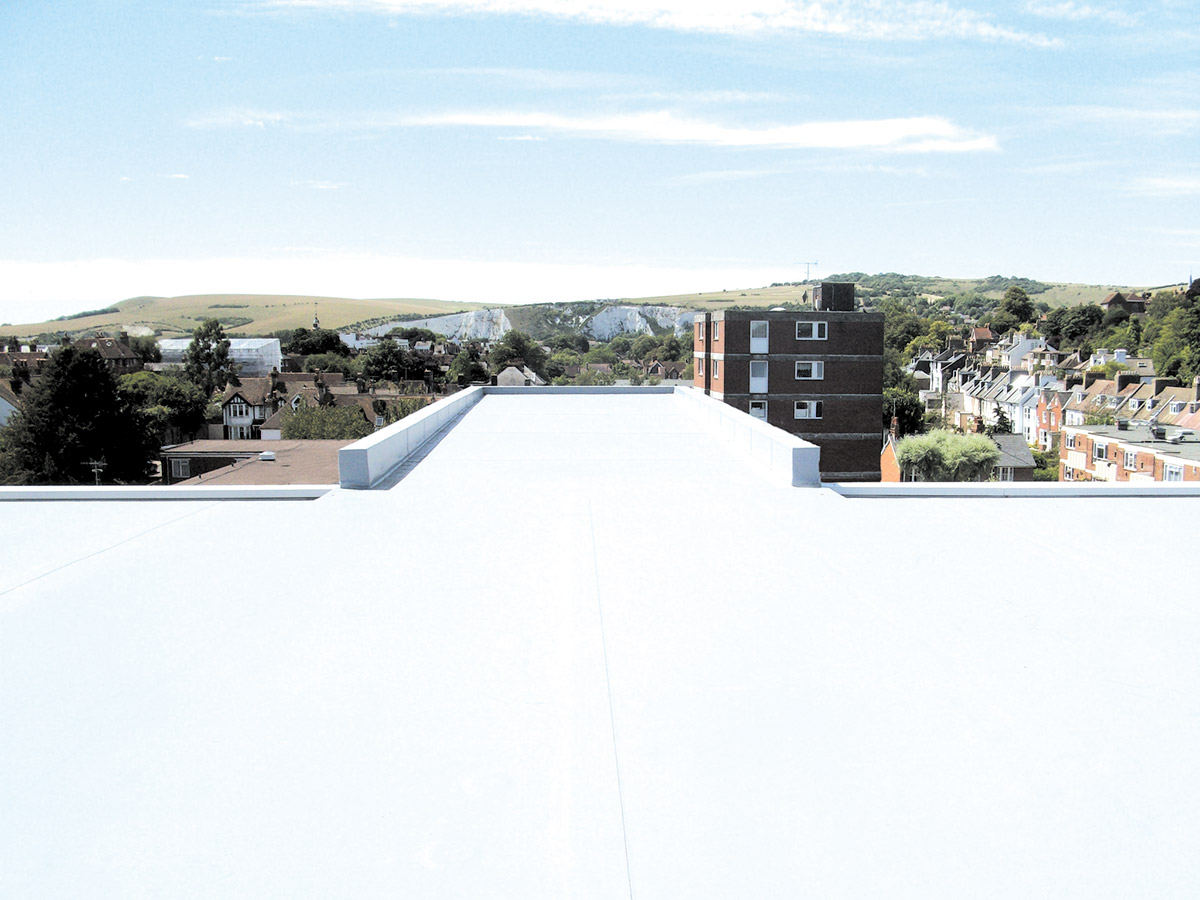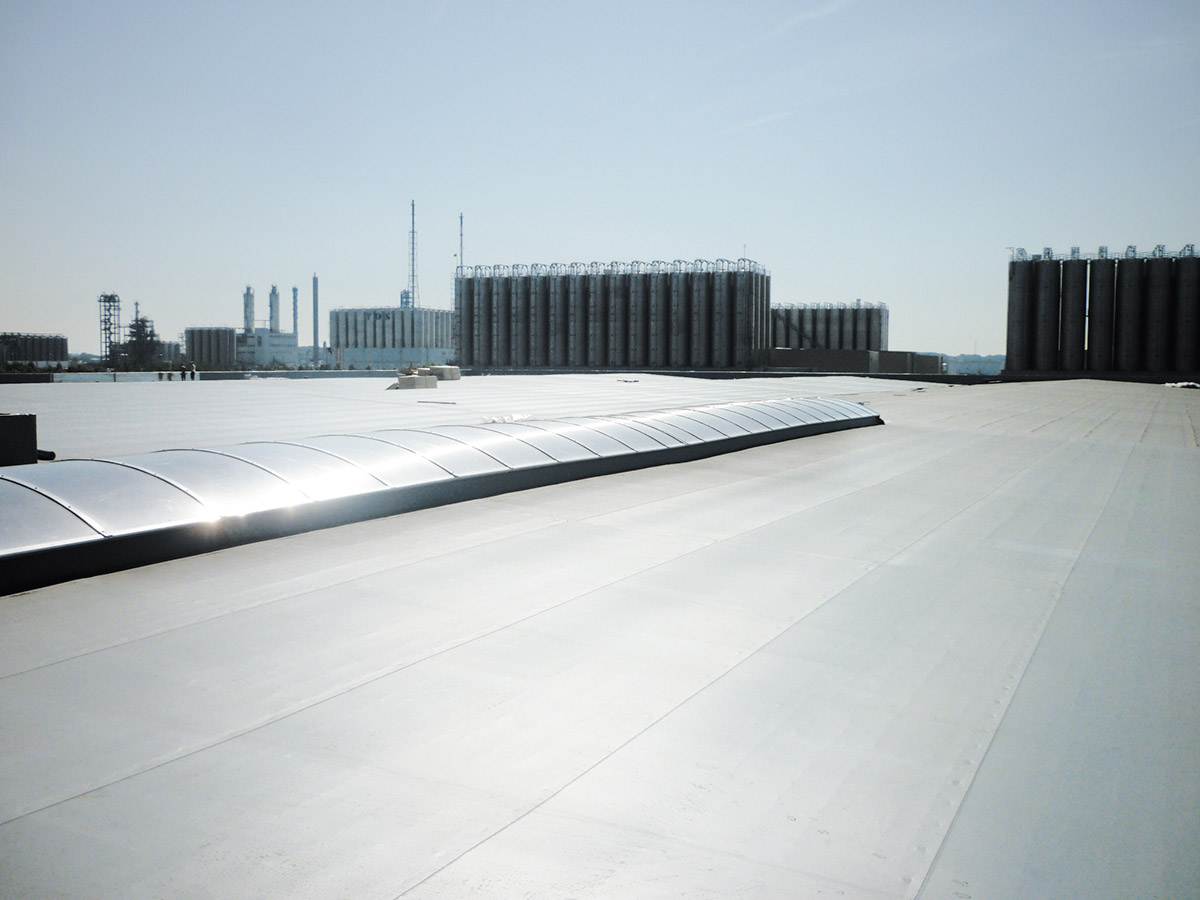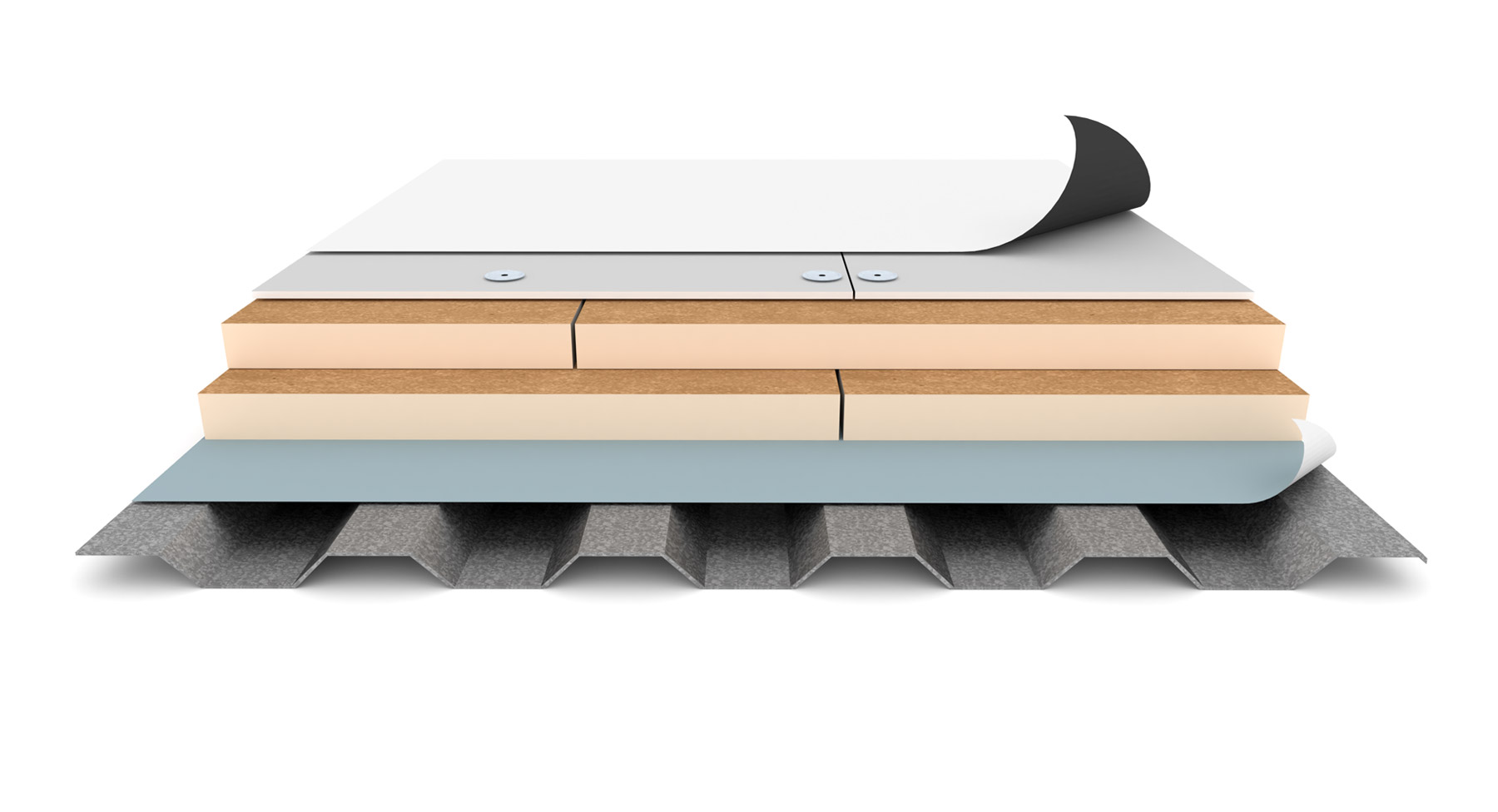Please note that this article is intended to provide general information only about commercial roofing systems and is not a substitute for professional advice from a roofing contractor, architect, or other specifiers with respect to any particular roofing project.
When you speak with roofing contractors about a new flat roof, you may find that they have vastly different opinions about which roof attachment system is best. There are two main ways that a roofer may secure a single-ply roofing material to the rest of the roof: mechanically attached and fully adhered. While mechanically fastened roofs are more common, those contractors who swear by fully adhered roofs also have their reasons. So, which is the right choice for your commercial roof? Your building’s structure, current roofing system, environment, and budget should all play a part in your decision. Considering these factors and comparing the various opinions of roofers can be a challenge, but the comparison we offer below can help. Learn about what each attachment option entails, its cost, and when it should be chosen.
Table of Contents
- The Roof Attachment Types
- TPO Roofing Definition
- Mechanically Attached Roofs
- Fully Adhered Roofs
- Self-Adhering Roofing Systems
- The Benefits and Disadvantages of Mechanically Attached Roofs
- The Benefits and Disadvantages of Fully Adhered Roofs
- Comparison Chart for Mechanically Attached and Fully Adhered Roofs
- Which Should You Use?
The Roof Attachment Types
Though the top membrane on a flat roof is the only visible part of a completed roof, there are other layers of the roof beneath. Commercial roofs are entire systems designed to work together to protect the building from the elements. Along with the top layer of roofing material, there may be insulation, a vapor barrier, an overlay board, and more. It all depends on the specific design of the system you’re using. But in all systems, the top layer of a roof must be secured to the layers below.
TPO Roofing Definition
Commercial TPO Membrane Installation Pre-Wash
Fully adhered TPO (short for thermoplastic polyolefin) is a TPO roofing system that uses adhesive to secure the top level of the roof. Like other single-ply membranes, TPO can be applied in either of two attachment types we will discuss below.
IKO Single-Ply Roof Installation
For single-ply roofing systems such as TPO, EPDM, and PVC, there are two main roof attachment types: fully adhered and mechanically fastened. However, there are different attachment types for other roof systems. For example, some built-up roofs are ballasted. This means that roofers use a layer of gravel and other materials to weigh the roofing materials down and improve their performance. Although common, ballasted roofs may present problems, such as increasing the weight the building must bear and making maintenance and repair work more challenging. There are also torch-down roofs. The top layer of these roofs is secured down by melting the asphalt on the bottom of the membrane and pressing it down to seal with the layers below it. The use of an open flame may not be ideal for all applications.
As those two have significant drawbacks, most roofing contractors will now recommend that you instead choose one of three options: mechanically attached single-ply roof systems, fully adhered single-ply roof systems, or self-adhering roof systems.
Mechanically Attached Roofs
TPO membrane on mechanically fastened insulation to steel roof deck
Mechanically attached single-roofs are held down to the other layers of the roof with fasteners. There are some mechanically attached modified bitumen systems as well, but we will not cover them here. For single-ply mechanically attached roofs, the fasteners are typically screws, but the materials, length and other specifics of the fasteners are normally determined by the substrate of the roof. Steel and concrete decks, wood decks, and lightweight decks made of gypsum all require different fastener types. Roofers typically use plates along with the fasteners, which spread out the force the fastener applies to the membrane and make it more secure.
You should also know that the manufacturer of the specific roofing system you are installing will strictly dictate the pattern of the fasteners. A roof’s performance depends on the strength of the connection between the top membrane and the rest of the roof. In turn, this depends on where the roofers place the fasteners and how many they use. To receive the benefits of the roofing system’s limited warranty and to pass inspection, your roofer needs to install the correct fastener pattern. The roof will also need to meet the other installation requirements the manufacturer dictates (as will fully adhered roofs.)
Fully Adhered Roofs
While BUR and modified bitumen roofs may also be fully-adhered, here we will focus on single-ply fully adhered roofs. These are single-ply roofs that are held down with very strong adhesive. The roofers spread the adhesive out across the entire membrane, securing it to the layer beneath. This complete coverage is why these roofs are called “fully” adhered.
Installation of some fully adhered roofs can be difficult for roofers, as the adhesive can be challenging to work with and requires specific temperature conditions. It must be warm enough out for the adhesive to seal properly and sections of the fully adhered roof membrane have to be glued all at one time in order to apply the sheet without creating air pockets. It takes time and technique to apply adhesive to the entire surface and then roll the membrane out onto the roof. However, taking into account the considerations of their application, fully adhered roofs can offer several performance benefits that outweigh the challenges of installation. We’ll explain more about their benefits and drawbacks below.
Self-Adhered Roofing Systems
Sometimes referred to incorrectly as a self-adhering roofing system, another option for your roof is a self-adhered roofing system. This system includes self-adhered modified bitumen roofing material, which is an entirely different product than the single-ply membranes mentioned above. The manufacturer adds adhesive to self-adhered roofing rolls so roofers do not need to add it to the roof themselves, which can sometimes be a struggle. Otherwise, self-adhering roofs have many of the same elements as single-ply systems, including self-adhered membrane roofing underlayment, insulation, and more.
The Benefits and Disadvantages of Mechanically Attached Roofs
In many areas in North America, mechanically fastened roofs are more common than fully adhered roofs, at least among older buildings. They offer strong performance and typically cost less than fully adhered roofs. Unlike fully adhered roofs, mechanically attached roofs can be installed at a wider range of temperatures. The installation process for mechanically adhered roofs is typically much faster, further decreasing costs and the impact of roofing work on the occupants of your building. It is also much simpler for inspectors to verify that the fasteners were installed properly, as they can be detected on the roof (whereas adhesive cannot.) This can give you some additional peace of mind about the quality of your roof.
Despite their benefits, mechanically attached roof systems may underperform when compared to fully adhered roofs. They include more seams, as they use smaller and more membrane sheets, which means that they have more opportunities for leaks. They also may offer lower wind resistance and hail resistance ratings, although the hail rating also has a great deal to do with the substrate material on your roof. For these reasons, mechanically fastened roofs may end up with shorter lifespans. This lower durability is sometimes in part due to the “flutter” effect. Wind applies negative pressure to the membrane, lifting it slightly where it is not directly fastened down.
Still, mechanically attached roof systems can offer great performance while also meeting other needs you may have for your roof, including low-cost and short, simple installations.
The Benefits and Disadvantages of Fully Adhered Roofs
Fully adhered roofs cost more to install, largely because they take longer and require more tools and materials. Roofers need to cover each section of the membrane with adhesive, wait for it to be the correct tackiness and then apply the membrane with a weighted roller. Since all of this must be done at the correct temperature, fall or winter installation in cold climates may not be possible. While some newer adhesives can be installed at temperatures as low as 25°F (-4°C), this is not quite enough to allow for winter installation in many northern areas.
This installation process often takes more time and detail than other options, which typically will increase the cost. It is also impossible for inspectors to verify the quality of the adhesive after installation, as they can’t see it once the materials are glued down.
However, fully adhered roofs have great benefits as well. Frequently, these roofs achieve better wind resistance ratings than their mechanically attached counterparts. The pressure created by wind is evenly distributed across the whole surface of the roof, rather than being limited to the fastening points as with a mechanically attached roof. This performance benefit can be critical for buildings that are exposed to large wind forces. Although fully adhered roofs are not impervious to wind, they may “peel” off the surface beneath them in very high winds.
How about water penetration? On fully adhered roofs, roofers can use wider sheets of membranes, which means they have fewer seams and fewer opportunities for leaks. If a leak occurs in a fully adhered roof, the adhesive can possibly limit the spread of water beneath the membrane, which can lower the damage that a minor leak causes. On the other hand, it is possible for a leak in a fully adhered roof to avoid detection for longer due to the limited spread of water. Much will depend on the quality of the glue, which can be a solvent or water-based adhesive, depending on the requirements of the manufacturer.
As the benefits of fully adhered systems are becoming clearer to property owners and managers, fully adhered systems are becoming a more popular choice for new roof installations.
Comparison Chart for Mechanically Attached and Fully Adhered Roofs
| Mechanically Attached | Fully Adhered | |
|---|---|---|
| Materials Needed | Approved fasteners | Approved adhesive |
| Installation Speed | Faster | Slower |
| Installation Concerns | Can be installed in any weather | Needs warm weather for installation The smell of adhesive may be an issue |
| Costs | Less expensive | More expensive |
| General Performance Concerns | Good performance | Good performance with reduced likelihood of leaks Higher possibility leaks go undetected |
| Wind Resistance | May not achieve your desired wind rating | Potential for higher wind rating |
| Hail Resistance | Good, depending on the substrate material | May be superior, depending on the substrate material |
| Durability | Good | May be superior |
Which Should You Use?
So, which is better? The honest answer is that it depends on your building and your priorities. It makes sense for building managers and owners in high-wind areas or those who want a longer lifespan from their roof to lean towards fully adhered systems. Those who are more concerned about cost or ease of installation may prefer a mechanically attached roof. It is best to talk to a professional roofer you trust about your options and how the specifics of your property or your unique priorities play into your decision.However, when you are choosing between a mechanically attached and a fully adhered roof, you should be comparing complete roofing systems that are designed for these attachment types and not just considering the attachments without accounting for the other components of the system as a whole. There are some roofing systems of higher and lower quality of either type. Only whole systems achieve ratings that may matter to you, like a wind resistance or hail resistance rating. The best way to compare commercial roofing quotes is to make sure they are using the same system and reflect the same material costs. Choosing the overall system that provides the performance that you need is most important.
Explore our commercial roof systems, or learn more about the types of commercial roofs that are available on the market in general.



